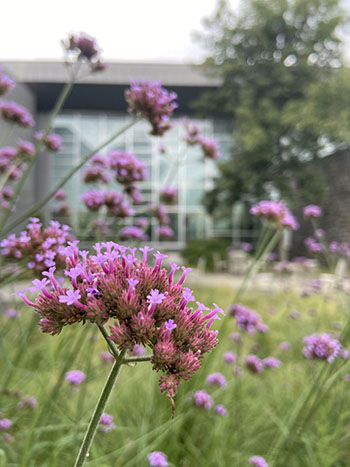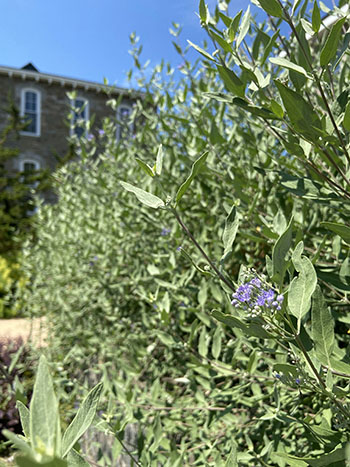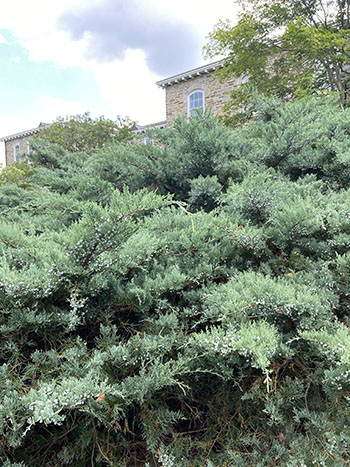
Plants of the Week: August 1
Guest Author: Public Horticulture Intern Megan Rossman

The past few weeks the arboretum and its surrounding environment has unfortunately been faced with drought conditions. A continued stretch of warm days, with little rain has provided a challenge to the gardeners working hard to tend to the stressed arboretum occupants. And while some plants have a bit of brown crispiness here and there, others fared quite well. I wish to highlight a few of these plants that thrived in these past couple of weeks; ones that may be good considerations for your personal garden moving forward in these changing climatic conditions.
In the sporobolus beds near the Science Center it is not uncommon to find a yellow finch grasping the sturdy stems of the Verbena bonariensis. Accompanying the finches you may find a variety of bees and beetles dutifully pollinating this herbaceous perennial. It is a delightful scene, the attractive plant swaying gracefully in the summer breeze being enjoyed by the local fauna.
Charming, airy, and drought resistant, Verbena bonariensis is a prime performer when it comes to dry times. Commonly known as tall verbena, this slender-stemmed plant displays rich lilac-colored flowers in tight clusters atop tall stems. Architecturally the stems provide a statement visually and functionally as their sturdy nature prevents them from needing staking support. Great in mass plantings in beds and borders, tall verbena thrives in full sun to light shade. Throughout the past few weeks the Verbena bonariensis remained unaffected by the lack of rain and continues to be a wonderful landscape feature. photo credit: M. Rossman

During my first week at the arboretum, a few of the other interns and I found our way up to the Pearson Hall Terrace for lunch. While sitting on the south facing benches we could see through the lilac collection all the way to the Arboretum offices. Now, if I were to sit on those same benches I would find that original view interrupted by a dusty green shrub that is about to be covered in small blue flowers.
This aromatic shrub is Caryopteris x clandonensis ‘Blue Mist’ (bluebeard) and it has continued to grow and thrive during this period of drought, without the need of watering from the gardeners. Growing to a height of 2-3 feet, bluebeard creates a wonderful hedge when planted en masse. Easily grown in full sun, this shrub will bloom in July through September and gives way to a fluffy cloud-like appearance. The flowers are attractive to butterflies, bees, and anyone seeking to add a bit of heavenly blue to their garden. photo credit: M. Rossman

I spent much of my childhood running wild through the western Colorado desert. A common camping past-time of mine was picking the small bluish “berries” off of the Juniperus osteosperma (Utah juniper), collecting them in my cupped hands, pretending I was harvesting food for dinner. While there are no Utah junipers in the Scott Arboretum, it was no surprise to find that its relative Juniperus virginiana ‘Grey Owl’ was doing just fine in these dry times.
This normally compact, wide-spreading evergreen can be found in the John W. Nason Garden. However, this specimen is anything but compact. With beautifully arched dusty silver-green foliage, this plant in particular spreads tall and wide and provides incredible textural interest to the landscape. Each cascading branch is full of the blue, berry-like cones that I so loved as a child.
Slow-growing and long-lived, the Juniperus virginiana ‘Grey Owl’ is a tough plant. It is heat, drought, and cold tolerant; it can prosper where others struggle. It is valued for providing year-round structure and for being a relatively low-maintenance shrub. This is a wonderful plant to consider adding to very dry, sunny sites, and if you are in need of an example look no further than the one in the John W. Nason Garden, it is sure to bring you childlike delight. photo credit: M. Rossman





No Comments